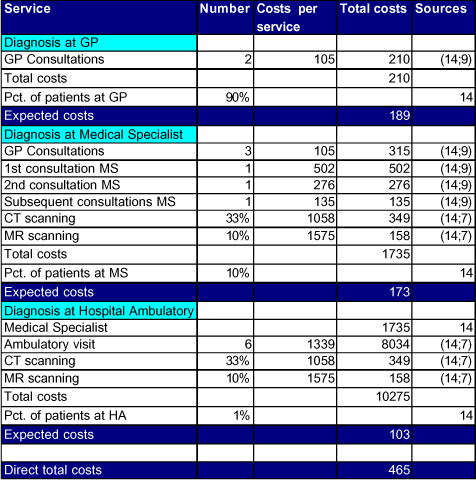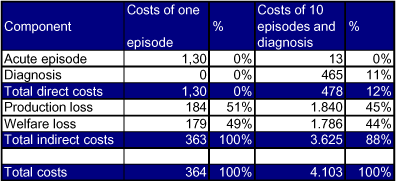|
Valuation of Chemical related Health Impacts 6 HeadacheHeadache is a common symptom, often associated with disability, but rarely life threatening. When a new headache occurs for the first time in close temporal relation to chemical exposure, it is coded as (secondary) headache attributed to the chemical (The International Classification of Headache Disorders (ICHD-II) (2003)). Headache may be acute or chronic. When exposure to a substance ceases but headache does not resolve or markedly improve after 3 months, a diagnosis of chronic post-substance exposure headache is considered. However, such headaches have not been documented in relation to chemicals and is therefore only for research purposes (ICHD-II (2003)). Hence, the headache considered in this section is acute headache induced by acute substance use or exposure. 6.1 DefinitionThe headache analysed in this section is defined as headache induced by acute substance use or exposure. This diagnosis is classified as 8.1 in ICHD-II (2003). For the present purpose, each episode is defined as " Two painful and splitting headaches during the day. Each period of headache will last two hours" (Navrud (1997). Operationalisation of this definition is made in Table 6-1 below. Table 6-1 Definition and operationalisation of acute headahce
* Navrud (1997) In is assumed that the patient is taking 2 DDD of analgesics and has 50% reduction in work ability during one episode of headache. 6.2 Chemicals associated with HeadacheThe following categories of chemicals are often mentioned to cause headache12:
Other type of chemicals may also cause headache depending on the intensity and length of time of exposure. 6.3 Disease courseThe patient may experience one or more episodes. It is not likely that the patient will seek medical assistance when having a few acute episodes of headache (Olesen, J. (2003)). In this situation, the patient may take analgesics to relief the headache. However, with multiple episodes of acute headache, it is likely that the patient will seek medical assistance and have a proper diagnosis established. In order to illustrate the costs in the two situations, the following cost estimates are provided:
6.4 Direct health care costsCosts of an acute episodeDirect costs of an acute episode of headache consist of drug costs only. It is assumed that the patient will take 2 DDD of mild analgesics, e.g. (paracetamol) in relation to an acute episode. The costs are estimated to be DKK 1.30 (2*0.65 =1.30). The costs of 10 acute episodes are calculated strait forward as 10*1.30 = DKK 13. Table 6-2 Direct costs per acute episode of headache (DKK 2002 values)
Costs are public costs only as the patient's co-payment is included in the indirect costs Cost of establishing the diagnosisIn Table 6-3 an overview of health care resources in relation to establishing a diagnosis is given. Most of these patients will be treated by the general practitioner (GP), and only very few patients will be further referred to Medical Specialist and Hospital Ambulatory. The distribution of patients among GP, Medical Specialist and Hospital Ambulatory is based on expert assessment by Jes Olesen (Olesen, J. (2003)). 90% of the patients will have 2 consultations at the GP only. The costs of two consultations at the GP are DKK 210. As 90% of the patients are treated at the GP only, the expected costs for the average patients are DKK 189 (0.9 *210 =189). The 10% of the patients being referred to the Medical Specialist has had 3 consultations at the GP before referral. At the Medical Specialist they will have 3 consultations. 33% will have a CT scanning and 10% will have a MR scanning. Total costs for patients diagnosed at the Medical Specialist are DKK 1735. As this is only 10% of the patients, the expected average costs are DKK 173. 1% of the patients will be further treated at the Hospital Ambulatory. Total costs for these patients are DKK 10.275 resulting in expected average costs of DKK 103. Total expected costs of establishing the diagnosis are therefore DKK 465 when expected costs for each category are added together. Table 6-3 Costs of establishing diagnosis for severe headache (DKK 2002 values)
Expected costs Total costs multiplied by the percentage of patients receiving the service 6.5 Individual welfare LossThe Definition of a day with moderate headache used in the present study is taken from the valuation study reported in Navrud (1997/2000), which will be used in the present context to estimate the welfare loss by benefit transfer. The CV survey is described in chapter 5.5 of the present report. The value per day of headache when 14 days are considered is about one third of the value on one day of headache. In the present study the value on one additional day is used, due to the present definition of an episode. The estimated value of avoiding an additional symptom day is DKK 195 (2002-prices). Purchasing power corrected per capita income level in 1997 was 9.4% higher in Norway that Denmark, resulting in a corrected estimate of DKK 179 per day. 6.6 Production lossIt has not been possible to get accurate data on the extent of absence from work due to moderate headache. For the present purpose it is assumed that a moderate headache in average leads to a degree of absence from work of 35%. This corresponds to a 50% reduction in the individuals work ability during an episode of moderate headache taken into account that appr. 70% of the episodes will appear on non-working days. This results in an average production loss of DKK 184 per episode. 6.7 Unit cost estimateThe total unit cost has been estimated for an episode of acute headache supplemented by an example of a scenario of 10 repeating headaches, including diagnosis settlement. The result is seen in Table 6-4 below. Table 6-4 Total unit cost of one and 10 episodes of acute headache (DKK 2002 values)
All episodes and diagnosis are within one year The total unit cost of one episode is estimated to DKK 364. It is apparent that the indirect costs are the most important component is the total costs of headache. For costs of one episode, the direct costs amounts less than 0.4% of the total costs. The production loss is the most important cost element contributing with app. 51% of the total costs followed by the welfare loss amounting 49%. Estimated cost of the defined scenario of 10 episodes including diagnosis is DKK 4,103. The direct costs now amount app. 11% of the costs, whereas the individual welfare loss and the production loss contribute with 44% and 45% respectively. In relation to the welfare loss in the scenario calculation one issue should be noted. As the WTP survey (Navrud, 1997) showed, the average WTP per headache day seems to be dependent on the total duration. Likewise, it is likely that the WTP per episode changes with the total number of episodes experienced within a certain period. The WTP survey pointed in the direction of decreasing WTP along with the increase of days of duration, which may also be the case for the defined scenario. On the other hand, since the cause in defined scenario is assumed to result in a need of diagnosis settlement it may give rise to increase worries and this increase the individual WTP. Following this, the WTP for one episode of headache during one day is used in the scenario estimation as well. Footnotes12 EPA US Enviromental Agency (1995). http://immuneweb.org/articles/fabricsoftener.html
|
||||||||


